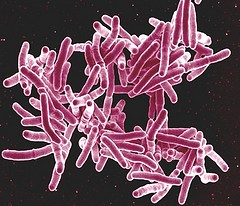Tuberculosis (TB) is primarily an airborne disease caused by the bacteria Mycobacterium tuberculosis, which are spread person-to-person through the air. This bacteria mainly affects the lungs, but may adversely affect other organs.
Individuals who are exposed to TB often do not feel sick or present any symptoms. These individuals are not contagious at this point, unless their infection persists into active TB disease. At this point the bacterium can be spread through microscopic droplets as the patient sneezes, coughs, talks, or otherwise projects contaminated sputum/saliva from their body. People nearby may breathe in these bacteria and become infected as the bacteria can stay in the air for several hours.
As a top infectious disease, current estimates are that TB infects nearly two billion people or about one-third of the world population. These infected, non-disease active people are considered latent TB cases. This means that people are infected with TB bacteria, but are not yet ill or active cases. Infected people have a lifetime risk of 10 percent to falling ill to TB.
According to the World Health Organization, in 2014 9.6 million people had developed active TB illness and 1.5 million died from the disease. During 2014, the CDC reported that 9,421 active TB cases were recorded within the United States. There were 108 cases of TB disease in Indiana in 2014.


